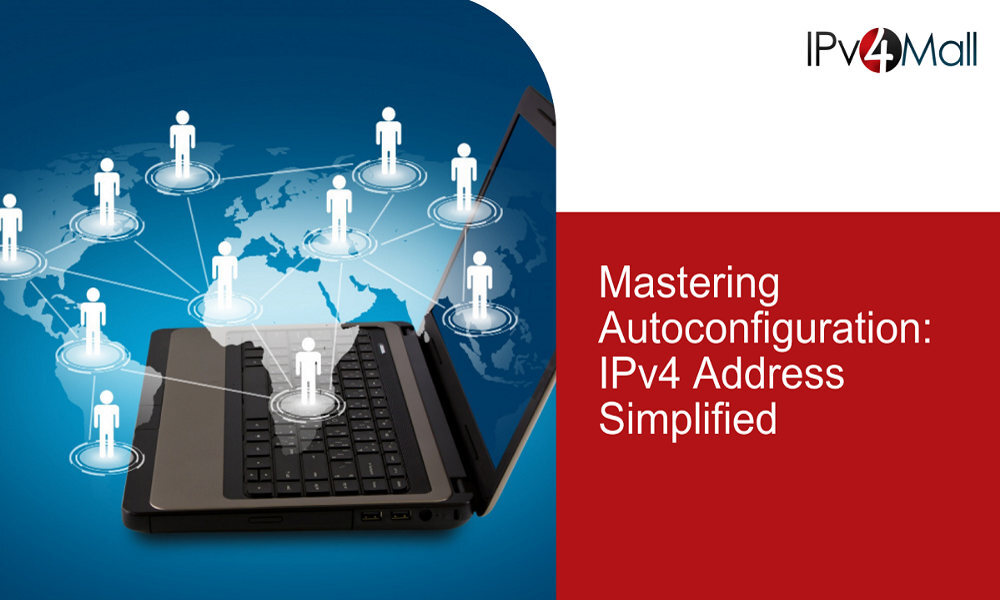![]()

November 8, 2023
Mastering Autoconfiguration IPv4 Address Simplified
In today’s fast-paced and interconnected world, the importance of understanding IPv4 address autoconfiguration cannot be overstated. Whether you are an IT professional, a network administrator, or just a curious tech enthusiast, delving into the intricacies of IPv4 address assignment is a valuable pursuit.
In this comprehensive guide, we will explore the intricacies of IPv4 address autoconfiguration, providing you with the knowledge you need to master this critical aspect of networking.
The Significance of IPv4 Address Autoconfiguration
IPv4, or Internet Protocol version 4, has been the backbone of the Internet for decades. Every device connected to the Internet requires a unique IP address to communicate effectively.
In the early days of networking, these addresses were assigned manually, a cumbersome and error-prone process. This led to the development of autoconfiguration methods, which simplified the assignment of IP addresses.
IPv4 address autoconfiguration plays a vital role in simplifying the setup of networks, ensuring that devices can communicate seamlessly without human intervention. It eliminates the need for manual configuration and significantly reduces the risk of errors that can disrupt network functionality.
DHCP and IPv4 Autoconfiguration
Dynamic Host Configuration Protocol (DHCP) is one of the most widely used methods for IPv4 address autoconfiguration. DHCP servers on a network automatically assign IP addresses to devices when they join the network. This process eliminates the need for manual configuration, making it a preferred choice in most scenarios.
However, there are situations where DHCP may not be available, or you may prefer a more straightforward approach to autoconfiguration. This is where IPv4 link-local addressing comes into play.
IPv4 Link-Local Addressing
IPv4 link-local addressing is a simplified autoconfiguration method that allows devices to assign themselves an IP address when no DHCP server is available. This approach is particularly useful in scenarios like small, isolated networks, or when you need a quick and temporary connection.
When a device uses link-local addressing, it assigns itself an IP address from a specific range (169.254.0.0 to 169.254.255.255). This self-assigned address allows the device to communicate with others on the same network segment, even if no DHCP server is present. While it may not be suitable for all situations, link-local addressing provides a straightforward and reliable method for automatic IP assignment.
How to Implement IPv4 Link-Local Addressing
Implementing IPv4 link-local addressing is a straightforward process, and it can be achieved in just a few simple steps:
Check Network Connectivity: Ensure that your device is connected to the network segment you want to configure. Link-local addressing is limited to communication within the same network segment.
Enable IPv4 Link-Local: Most modern operating systems enable link-local addressing by default. However, it’s essential to verify that it’s enabled in your network settings.
Verify Address Assignment: After enabling link-local addressing, your device will automatically assign itself an IP address from the 169.254.0.0 to 169.254.255.255 range. You can check your device’s IP address to confirm the assignment.
Test Communication: With the link-local address in place, you can now communicate with other devices on the same network segment. This can be valuable for troubleshooting or establishing temporary connections.
Common Scenarios for IPv4 Link-Local Addressing
IPv4 link-local addressing is a versatile tool that can be used in various scenarios, including:
Network Troubleshooting: When you encounter network issues, using link-local addressing can help you quickly test connectivity and isolate problems.
Ad Hoc Networks: In situations where you need to set up a temporary network between devices, such as in a meeting room or at an event, link-local addressing simplifies the process.
Limited DHCP Resources: In environments with limited DHCP resources or where DHCP servers are not available, link-local addressing ensures devices can still communicate effectively.
Zero-Configuration Networks: Link-local addressing is a fundamental component of zero-configuration networking protocols, like Bonjour in Apple products. It enables devices to discover and communicate with each other without manual configuration.
IPv4 Address Autoconfiguration Best Practices
To make the most of IPv4 address autoconfiguration, consider the following best practices:
Maintain Network Segmentation: Ensure that devices using link-local addressing are within the same network segment. Link-local addresses are not routable outside of their local network.
Combine DHCP and Link-Local: In some network setups, it’s beneficial to have a combination of DHCP and link-local addressing. This provides flexibility and redundancy in IP address assignment.
Regularly Monitor Network Status: Keep an eye on the performance and status of devices using autoconfigured IP addresses. This helps identify and address issues promptly.
Security Considerations: While link-local addressing simplifies autoconfiguration, it’s essential to consider security implications. Ensure that unauthorized devices cannot gain access to your network through link-local addressing.
Conclusion
In the ever-evolving world of networking, mastering IPv4 address autoconfiguration is a valuable skill. Whether you opt for the convenience of DHCP or the simplicity of link-local addressing, understanding how devices automatically assign IP addresses is crucial for maintaining efficient and reliable networks.
By following best practices and making informed choices, you can ensure that your network operates smoothly and securely, even in the absence of dedicated DHCP servers. IPv4 address autoconfiguration simplifies the management of IP addresses and empowers you to build and maintain efficient networks with ease.
Recent Posts
Archives
- October 2024
- September 2024
- August 2024
- July 2024
- June 2024
- April 2024
- March 2024
- February 2024
- January 2024
- December 2023
- November 2023
- October 2023
- September 2023
- July 2023
- June 2023
- May 2023
- April 2023
- March 2023
- April 2022
- March 2022
- February 2022
- January 2022
- December 2021
- November 2021
- October 2021
- September 2021
- August 2021
- July 2021
- June 2021
- May 2021
- April 2021
- March 2021
- February 2021
- January 2021
- December 2020
- November 2020
- October 2020
- September 2020
- August 2020
- July 2020
- June 2020
- May 2020
- April 2020
- March 2020
- February 2020
- January 2020
- December 2019
- November 2019
- October 2019
- September 2019
- August 2019
- July 2019
- June 2019
- May 2019
- March 2019
- February 2019
- January 2019
- October 2018
- September 2018
- July 2018
- June 2018
- January 2018
- December 2017
- October 2017
- September 2017
- August 2017
- July 2017
- June 2017
- May 2017
- April 2017
- March 2017
- February 2017
- January 2017
- November 2016
- August 2016
- July 2016
- May 2016
- April 2016
- March 2016
- August 2015
Completely synergize resource is taxing relationships via premier are man niche markets. Professionally cultivate one to one customer.
Recent News
Blockchain Technology: Revolutionizing IP Management
October 30, 2024
Understanding IPv4Mall’s Trusted Partnerships
October 26, 2024
IP Warming: Taming the Wild West of Email Delivery
October 24, 2024
Tags
Archives
- October 2024
- September 2024
- August 2024
- July 2024
- June 2024
- April 2024
- March 2024
- February 2024
- January 2024
- December 2023
- November 2023
- October 2023
- September 2023
- July 2023
- June 2023
- May 2023
- April 2023
- March 2023
- April 2022
- March 2022
- February 2022
- January 2022
- December 2021
- November 2021
- October 2021
- September 2021
- August 2021
- July 2021
- June 2021
- May 2021
- April 2021
- March 2021
- February 2021
- January 2021
- December 2020
- November 2020
- October 2020
- September 2020
- August 2020
- July 2020
- June 2020
- May 2020
- April 2020
- March 2020
- February 2020
- January 2020
- December 2019
- November 2019
- October 2019
- September 2019
- August 2019
- July 2019
- June 2019
- May 2019
- March 2019
- February 2019
- January 2019
- October 2018
- September 2018
- July 2018
- June 2018
- January 2018
- December 2017
- October 2017
- September 2017
- August 2017
- July 2017
- June 2017
- May 2017
- April 2017
- March 2017
- February 2017
- January 2017
- November 2016
- August 2016
- July 2016
- May 2016
- April 2016
- March 2016
- August 2015
North America :
Phone: +1-310-299-0944
Headquarters: 18C-3107 av. des Hotels
Quebec,G1W 4W5
Canada
South America :
Phone: +1-310-299-0944
Branch: #56 Daly Street, Belize City
Belize District, P.O. Box 1825
Belize











Recent Comments